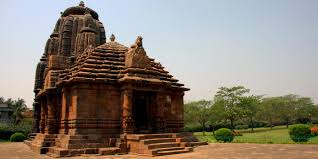Exploring the Majesty of Raja Rani Temple: A Glimpse into Bhubaneswar's Temple City
Bhubaneswar, the capital city of Odisha in India, is not just a modern metropolis but a repository of ancient heritage and architectural marvels. Known as the 'Temple City of India,' Bhubaneswar boasts of a rich history dating back to over two thousand years. Its name itself is derived from the Sanskrit words "Bhubaneshwar," meaning the Lord of the Universe, reflecting its spiritual and cultural significance.
Source
The epithet 'Temple City' is aptly bestowed upon Bhubaneswar due to its unparalleled concentration of temples. With more than 600 temples spread across the city, it stands as a testimony to the rich architectural heritage of India. These temples, dating from different periods of history, exhibit diverse architectural styles, reflecting the cultural amalgamation that Bhubaneswar has witnessed over the centuries.
The architectural landscape of Bhubaneswar is characterized by its unique temple architecture, predominantly showcasing the Kalinga style of architecture. This style is characterized by its emphasis on intricate carvings, spires, and elaborate sculptures depicting mythological narratives and religious motifs. The temples are predominantly built using sandstone and laterite, lending them a warm reddish hue, which is characteristic of the region.
The temples of Bhubaneswar serve as not just religious centers but also as architectural marvels that attract tourists and scholars from around the world. They provide invaluable insights into the socio-cultural and religious ethos of ancient India, showcasing the craftsmanship and ingenuity of the artisans of yore.
Among the myriad temples that adorn the landscape of Bhubaneswar, the Raja Rani Temple holds a special place. Built in the 11th century CE, during the reign of the Kalinga dynasty, the Raja Rani Temple is a masterpiece of architectural finesse and aesthetic grandeur. Though it is not dedicated to any specific deity, its name translates to 'King and Queen,' possibly referring to the sculptures adorning its walls.
The Raja Rani Temple is renowned for its unique architectural style, which combines elements of both Hindu and Jain architecture. The temple stands as a testament to the syncretic cultural ethos of medieval India. One of the most striking features of the temple is its intricate carvings, depicting various deities, celestial beings, and mythical creatures. The temple is adorned with ornate sculptures of apsaras, gandharvas, and other celestial beings, each intricately detailed and exquisitely crafted.
Source
One of the most striking features of the Raja Rani Temple is its absence of a central deity idol inside the sanctum sanctorum, a departure from the typical Hindu temple architecture. Instead, the temple is adorned with intricately carved sculptures of various deities, celestial beings, and mythical creatures, showcasing the exquisite craftsmanship of the artisans of yore.
The exterior walls of the temple are adorned with ornate carvings depicting scenes from Hindu mythology, including episodes from the Ramayana, Mahabharata, and Puranas. The intricate detailing and finesse of these carvings are a testament to the skill and dedication of the artisans who painstakingly crafted them centuries ago.
The Raja Rani Temple holds immense religious and historical significance. While the exact deity worshiped in the temple remains unknown, it is believed to have served as a place of worship for both Hindus and Jains during its heyday. The temple's intricate carvings and architectural splendor make it a popular pilgrimage site and a must-visit destination for tourists and history enthusiasts alike.
The Raja Rani Temple is just one of the many hidden archaeological gems scattered across India, waiting to be discovered and appreciated by future generations. Despite its historical and cultural significance, it remains relatively unknown to the general public, overshadowed by more prominent tourist attractions.
As we marvel at the architectural brilliance of the Raja Rani Temple, let us also remember that there are countless other hidden treasures waiting to be unearthed, each offering a glimpse into India's rich and diverse cultural heritage. Through continued exploration and preservation efforts, we can ensure that these hidden gems are not lost to the sands of time but cherished for generations to come.
Source
The Raja Rani Temple stands as a shining example of Bhubaneswar's rich architectural heritage and cultural legacy. Its exquisite architecture and intricate carvings are a testament to the artistic prowess of ancient Indian artisans. As we marvel at the splendor of this architectural gem, let us also remember that there are many more hidden treasures waiting to be unearthed, reminding us of the rich tapestry of India's cultural heritage.






Comments
Post a Comment